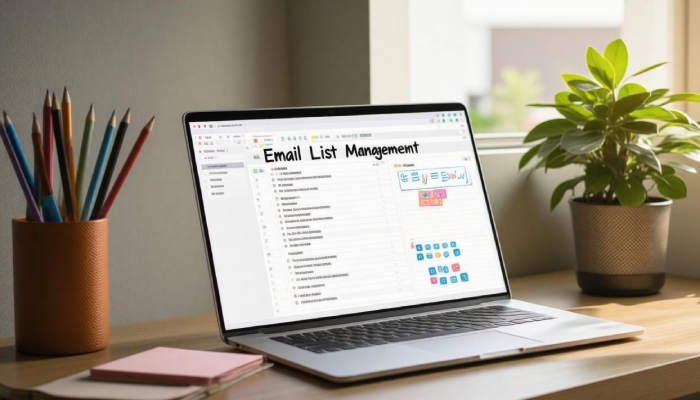How to Test Email Deliverability: A Comprehensive Checklist
Email marketing can feel like sending messages into a vast ocean, hoping they’ll wash ashore to your intended audience. But how do you ensure that the emails you craft with care don’t get lost in the digital waves? Testing email deliverability is essential; if your emails aren’t reaching inboxes, undoubtedly your campaigns will suffer. Luckily, there are straightforward methods to assess and improve how your emails perform. In this guide, we’ll look closely at various strategies and tools that can help you understand email metrics and boost your delivery success. Let’s dive into the details!
You can test email deliverability by sending a test message to a reliable service like MxToolbox, which analyzes various factors such as email headers, your IP address’s blacklist reputation, and SPF records. This analysis provides critical insights into potential issues affecting your email performance and offers recommendations for improvement.

Identifying Key Email Metrics
Let’s explore the specific metrics that can illuminate the performance of your email campaigns. Each metric serves as a lens through which to assess how well your emails are connecting with your audience.
Open Rate refers to the percentage of recipients who clicked on your email and opened it. This number gives valuable insight into whether your subject lines are captivating enough to draw attention. A low open rate may indicate that your subject lines are lackluster or that your sender reputation is suffering—a crucial aspect that you cannot afford to neglect.
As you evaluate these engagement levels, another pivotal metric comes into play: the Click-Through Rate (CTR).
The Click-Through Rate (CTR) shows you the percentage of folks who not only opened your email but also engaged with its content by clicking on links. A high CTR reflects that your message resonates well and encourages action, while a low rate may imply timid calls-to-action or irrelevant material to your audience’s interests. This is your opportunity to craft more engaging content—don’t shy away from experimenting with fresh ideas or formats!
Now that we’ve unpacked engagement, let’s also consider what might keep people from receiving your emails altogether:
The Bounce Rate provides important insights regarding deliverability issues. It comprises both soft bounces, which are temporary hindrances like a recipient’s full inbox, and hard bounces, indicating more serious problems such as invalid email addresses. Keeping an eye on this metric allows you to maintain a clean list, subsequently boosting your sender reputation. Too many hard bounces can tarnish it significantly, making future deliveries more difficult.
Continuing on this path, understanding why recipients might choose to disengage is equally important.
Tracking the Unsubscribe Rate reveals how many individuals opted out after receiving your communication. A high unsubscribe rate often hints at disconnect; perhaps the content isn’t resonating or it’s arriving too frequently for their liking. This information provides critical feedback; tailor your messaging so it aligns closely with subscriber preferences.
Lastly, there’s one more metric that serves as a litmus test for how recipients view your emails:
The Spam Complaint Rate indicates how many individuals marked your communications as spam. A high spam complaint rate can severely damage your sender reputation and inhibit future delivery efforts, making it pivotal to keep this figure as low as possible. You can manage this by ensuring consistent value in what you send out and maintaining permission-based lists where individuals have explicitly shown interest in receiving updates from you.
With all these metrics in mind, regularly monitoring them will provide a clear picture of how well—or poorly—your email campaigns are performing, guiding any needed strategy pivots as you move forward.
Essential Tools for Testing

When it comes to ensuring that your emails actually land in the right place, having the right tools at your disposal is crucial. These tools offer ways to analyze and improve your email strategies, ultimately aiding in optimal inbox placement.
MxToolbox
One of the standout options available is MxToolbox. This handy platform offers comprehensive reports that dive deep into various aspects of email deliverability. By meticulously examining your email headers, blacklist status, and SPF records, MxToolbox helps identify potential issues that could hinder your emails from reaching their final destination.
This tool acts as your personal inspector, uncovering unseen obstacles that might affect your sender reputation and credibility. Utilizing MxToolbox not only enhances your understanding but also informs actionable steps towards improvement.
Mail Tester
Another effective resource is Mail Tester, which takes a simple yet impactful approach. Once you send an email to its platform, you receive a detailed report card—yes, just like school! This report assesses your email’s content based on several critical technical metrics such as SPF alignment and DKIM signatures while also highlighting any potential spam triggers.
With this feedback in hand, you can make data-driven adjustments before hitting “send,” significantly increasing the chances of landing in subscribers’ primary inboxes.
GlockApps
Next up is GlockApps, a powerful tool designed for thorough testing. What sets GlockApps apart is its ability to send emails to a variety of test addresses across different ISPs to evaluate where messages land—be it the inbox, spam folder or elsewhere.
It doesn’t just stop there; GlockApps also identifies issues related to authentication protocols, helping you ensure that all your compliance checks are in place. The insights gained from this tool grant marketers clarity on how their emails perform within diverse environments, allowing for more refined strategies down the line.
While these tools provide essential insights into deliverability, it’s important to consider deeper layers influencing the success of email campaigns, leading us to understand the critical elements at play behind the scenes.
Factors Influencing Delivery

A multitude of factors can impact whether your email ends up in the inbox or spam folder. Each plays a critical role in determining how your message is perceived and what action is taken. Understanding these factors will empower you to fine-tune your email strategies for better success rates.
Sender Reputation
Your sending IP’s reputation is paramount to your email deliverability. Internet Service Providers (ISPs) analyze this score based on behaviors like your sending history, bounce rates, and spam complaints. For instance, if many recipients send your emails to their spam folders, ISPs take note. A poor reputation can result in emails being filtered out before even reaching the recipient.
To safeguard your sender reputation, maintain clean lists—remove inactive users and monitor engagement closely. A consistent track record helps establish trust with ISPs and can dramatically elevate delivery rates.
Email Content
The content within your emails holds significant weight as well. Quality and relevance are crucial factors; it’s not just about what you say but how you say it. Emails brimming with spammy phrases—think “Buy now!” or “Free!”—can quickly trigger spam filters, regardless of how genuine your intentions may be.
Instead, aim for engaging and relevant content that resonates with your readers while also aligning with their interests. It’s essential to strike a balance; ensure a proper text-to-image ratio and avoid excessive promotional language, which might lead to red flags in filter evaluations. With Nureply, you can streamline this process and craft messages that hit the mark without triggering spam filters.
A focused approach in creating valuable content helps foster trust and enhances any reader’s inclination toward opening—rather than blocking—your communications.
Authentication Protocols
Employing authentication protocols like SPF (Sender Policy Framework), DKIM (DomainKeys Identified Mail), and DMARC (Domain-based Message Authentication, Reporting & Conformance) are fundamental components for achieving higher deliverability rates. These tools serve to authenticate your identity as a sender, enhancing credibility in the eyes of ISPs. If a receiving server cannot verify where an email comes from, there’s a palpable risk that it will end up classified as spam or junk.
It’s wise to work closely with your IT team or hosting service to ensure these protocols are correctly configured and implemented. Not only does this add layers of protection against malicious spoofing attempts but also greatly increases the chance of passing through those pesky spam filters.
By managing these critical elements effectively, you place yourself in a better position to enhance communication reach and effectiveness. Now let’s explore effective ways to elevate your performance even further.
Steps to Improve Performance

The way you manage your email list can make a world of difference when it comes to reaching your audience. One of the key things you should do is validate email addresses before they even hit your list. Using services like NeverBounce or ZeroBounce can help ensure these addresses are legitimate, minimizing bounce rates. The last thing you want is for your hard work to be dismissed because emails are bouncing back, damaging your sender reputation. Consider the potential increase in engagement from a clean and verified list.
Step 1: Validate Email Addresses
By proactively validating emails, you prevent uninterested or incorrect addresses from cluttering your subscriber base. This simple step will keep your metrics looking healthy and remind ISPs that you’re a serious sender—one who cares about their audience and their professional image.
Once you have validated your email address, it’s time to add another layer of security and credibility by implementing authentication protocols.
Step 2: Implement Authentication Protocols
Setting up SPF, DKIM, and DMARC for your domain isn’t just a technical necessity; it’s about building trust with both email providers and your recipients. SPF verifies that your emails come from an authorized server, while DKIM adds an encrypted signature. DMARC takes it a step further by allowing you to monitor misuse of your domain, which protects you from being flagged as spam. All these measures create a safety net, significantly improving the chances your emails will end up in inboxes rather than spam folders.
Now that you’ve secured your emails, the next essential piece is focused on content creation because what you say matters just as much as how you send it.
Step 3: Craft Compelling and Compliant Content
Consider crafting your email content like writing a well-thought-out letter to a friend—it should be engaging and concise. That means avoiding trigger words that might raise red flags for spam filters while also ensuring that the subject lines are clear and direct. Personalizing the body of your emails can boost engagement rates significantly because recipients appreciate feeling valued as individuals rather than numbers on a list.
Content creation seamlessly flows into how often you reach out to your subscribers.
Step 4: Monitor and Adjust Frequency
Maintaining an appropriate frequency for sending emails is crucial for keeping your audience engaged without overwhelming them. It’s a delicate balance; too many emails can lead to unsubscribe requests or spam complaints, while too infrequent communication might cause recipients to forget about you entirely. A good rule of thumb is to create a schedule that allows consistent engagement—perhaps once or twice a month—ensuring that you’re present but not pushy.
Healthy email practices can create long-term relationships with subscribers that benefit everyone involved; they become more than just a number—they turn into loyal customers eager to engage with what you have to offer.
Building on these foundational steps paves the way for enhancing subscriber engagement through careful management practices going forward.
Effective List Management

One of the cornerstones of a successful email marketing strategy is efficient list management. Think of your email list as a garden; unless you regularly tend to it—removing weeds and ensuring the right plants are nurtured—it can become overgrown and unmanageable, leading to reduced yield. This principle applies directly to your subscribers: by keeping your list fresh and engaged, you increase your chances of successful engagement while protecting your sender reputation.
Regular List Cleaning
One essential practice is routine list cleaning. Every so often (ideally every 6-12 months), take a close look at your subscribers’ activity. Those who haven’t opened or clicked on any emails are potential candidates for removal from your list. However, don’t rush to cut them loose! Implement a re-engagement campaign first. Craft a few enticing emails tailored specifically for these inactive members, encouraging them to reestablish a connection with your content. By doing so, you give them a chance to reaffirm their interest before ultimately deciding to remove them from your subscriber base.
Remember, while broad lists seem attractive, quality far outweighs quantity in the realm of email marketing.
Segmentation
Moving on to segmentation—this is where the magic truly happens. Consider how personal experiences shape preferences; similarly, segmenting your email list based on user behavior, preferences, or demographics allows for greater relevance in each message you send. If you know a group of subscribers is particularly interested in outdoor gear versus someone who loves baking, tailoring your emails accordingly makes all the difference. This targeted approach improves engagement and boosts open and click-through rates as well.
To facilitate this process, analyze previous interactions and group similar subscribers together based on shared interests. Creating specific segments might allow for unique campaigns that speak directly to different audience types—be it hobbyists, regular buyers, or occasional browsers. The more relevant the content appears to each group, the more engaged they will be.
Consent Verification
Last but certainly not least, verifying consent is crucial for any emailing endeavor. It’s especially important as privacy regulations like GDPR evolve and change. By regularly confirming that subscribers still want to receive emails from you, you’re not just staying compliant; you’re nurturing trust within your audience. This practice protects you from potential legal ramifications and reflects positively on your brand’s integrity.
Incorporate straightforward consent verification techniques into your processes—send periodic reminders asking if they still wish to receive communications or make it easy for them to opt-in again during significant policy changes. Ultimately, this reinforces loyalty while enhancing engagement and cultivates an environment where subscribers feel valued.
Properly interpreting the data you gather can powerfully enhance your email campaigns. With these refined practices in place, you’re ready to explore how to analyze and extract valuable insights from those metrics.
Interpreting and Analyzing Data

Once you’ve collected your email metrics, it’s time to analyze the numbers to derive meaningful insights. The objective here isn’t just to look at the figures but to understand why they appear as they do. Effective data analysis can be the difference between a mediocre campaign and an exceptionally successful one.
Data Visualization
One of the most helpful tools in this process is data visualization. Transforming raw data into visual formats like graphs and charts makes trends easier to identify.
For example, using tools such as Google Data Studio or Tableau allows you to create comprehensive dashboards that display essential email metrics over time. By tracking performance visually, you can easily spot patterns—like whether open rates tend to dip during certain periods—and pivot your strategy accordingly.
Benchmarking
Now let’s talk about benchmarking, which is like conducting an annual physical for your email campaigns. Just as you’d compare your health metrics with recommended levels, checking industry benchmarks gives you a standard to aim for. A notable resource is Mailchimp’s report indicating an average open rate of around 21.33% across various industries. This figure serves as a guideline; analyzing how you stack up against competitors can reveal where you need improvement in engagement and click-through rates.
A/B Testing
As you refine your strategy based on these metrics, A/B testing becomes invaluable. This method involves sending variations of your emails—like different subject lines or content formats—to smaller segments of your audience and measuring their responses.
With this practice, you’ll uncover which elements resonate more effectively with recipients. If a playful subject line leads to higher open rates than a more formal one, it might be time to liven up your approach!
Ultimately, continuous monitoring and adjustment using these data-driven strategies ensure that you’re not merely reacting but proactively improving deliverability rates and overall campaign performance. By keeping an eye on trends, benchmarking against industry standards, and implementing insights gained through A/B testing, you’ll foster stronger connections with your audience while enhancing your email marketing effectiveness.
With the right tools and strategies at your disposal, you can elevate your email deliverability and turn insights into actionable plans that resonate with your audience. Stay vigilant and committed to improvement for ongoing success in your email campaigns.



